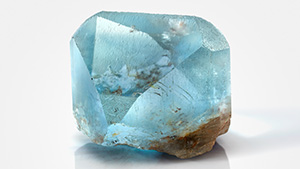
Topaz from Mason County, Texas
Roy Bassoo, Diane Eames, Matthew F. Hardman, Kenneth Befus, and Ziyin Sun, January 26, 2024
A comprehensive look at Texas topaz, detailing its gemological and compositional characteristics and providing a basis for using trace element concentrations to identify its origin.
Read More

Article
Winter 2023 G&G Available Now
Erica Zaidman, January 26, 2024
An overview of the Winter 2023 Gems & Gemology content.
Read More

A Unique Petrified Tree Fern from Northeast China
Ying Yan, Xiao-Yan Yu, Han-Yue Xu, and Zhi-Rong Xie, January 26, 2024
Documents the gemological properties, chemical composition, and appearance of petrified tree fern discovered in northeast China.
Read More

An Early Byzantine Engraved Almandine from the Garibpet Deposit, Telangana State, India: Evidence for Garnet Trade Along the Ancient Maritime Silk Road
H. Albert Gilg, Karl Schmetzer, and Ulrich Schüssler, August 6, 2018
Analyzes the chemical composition and inclusion characteristics of this ancient artifact.
Read More

Bohemian Garnets as Decorative Materials for Glass Vessels from the Late Sixteenth to Early Eighteenth Centuries
Karl Schmetzer, Hans Albert Gilg, and Hans-Jörg Ranz, January 26, 2024
Examines a technique for setting cut garnets on glass objects, invented by Claudius vom Creutz of Nuremberg in the late sixteenth century.
Read More

Demantoid, Andradite, and Grossular from Mexico
Aaron Palke, January 26, 2024
A look at new gem material from the iridescent andradite deposit in Sonora, Mexico.
Read More

Blue Amblygonite-Montebrasite from Rwanda
Wim Vertriest, Gil Yuda, and Joe Henley, January 26, 2024
A report on a new blue variety of amblygonite-montebrasite from Rwanda.
Read More

Texas Topaz, Slovak Opal, a Beryl Inclusions Chart, and More
Duncan Pay, January 26, 2024
An overview of the Winter 2023 Gems & Gemology content.
Read More

Article
Fall 2023 G&G Available Now
Erica Zaidman, November 3, 2023
An overview of the Fall 2023 Gems & Gemology content.
Read More

Yellow Sapphire: Natural, Heat-Treated, Beryllium-Diffused, and Synthetic
John L. Emmett, Ungkhana Atikarnsakul, Jennifer Stone-Sundberg, and Supharart Sangsawong, November 3, 2023
Investigates the various chromophores responsible for color in four types of yellow sapphire.
Read More








